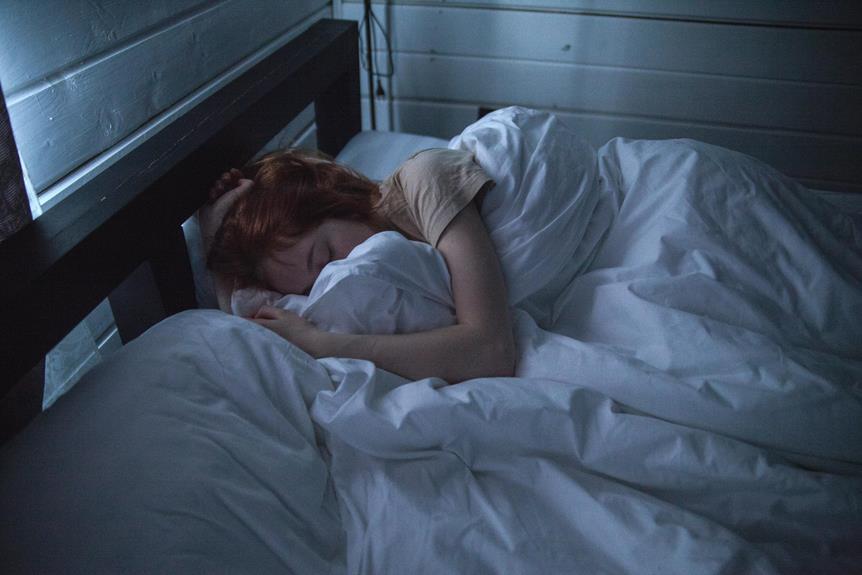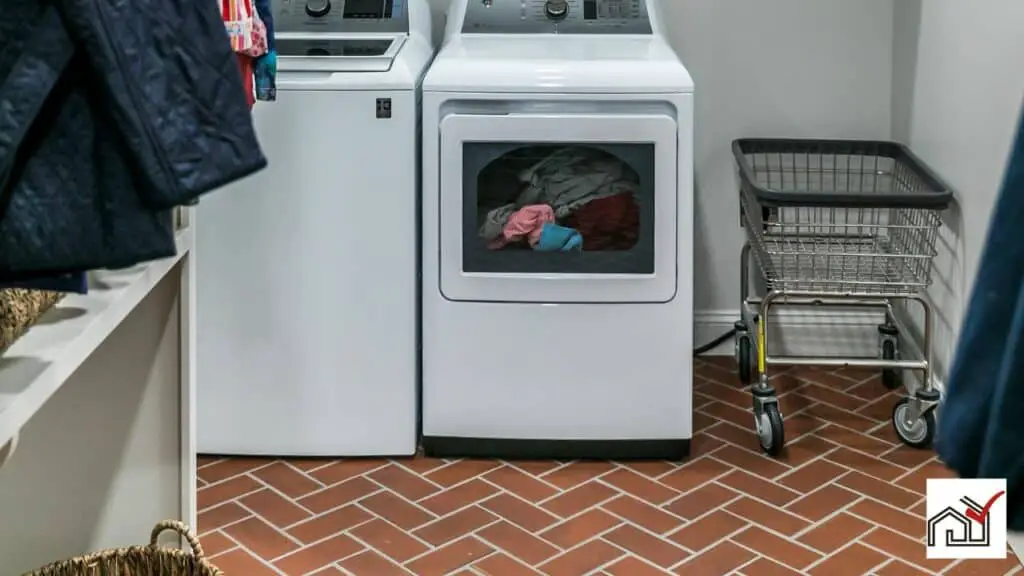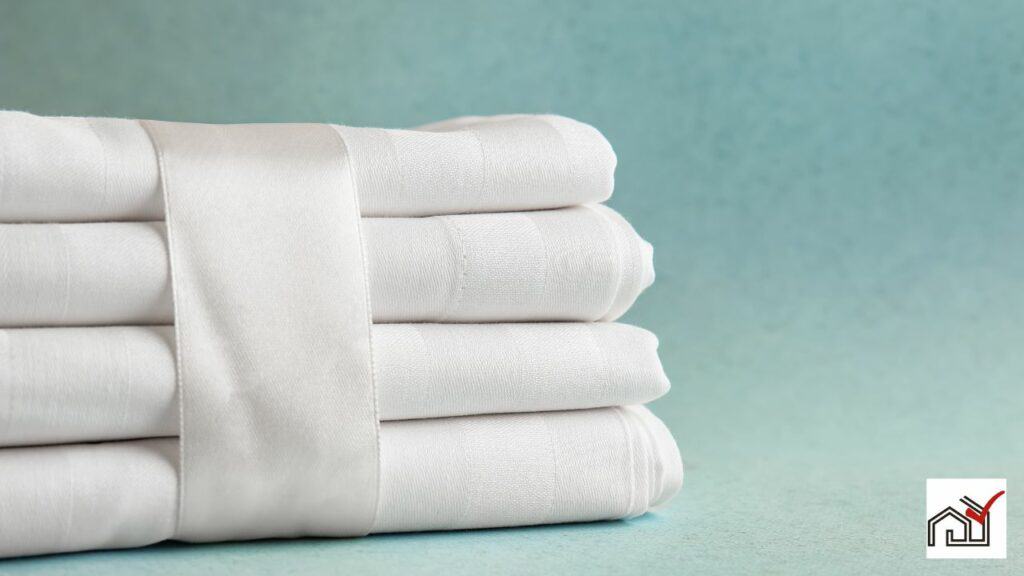To wash white sheets effectively, start by separating them from colored laundry to avoid color transfer.
Choose a detergent designed for white fabrics. Treat any stains with a pre-treatment product before washing.
Follow the fabric's care instructions and select a gentle or normal wash cycle with warm water.
For natural whitening, add baking soda or white vinegar to the wash.
Afterward, dry the sheets as per the care label, preferably air drying when feasible.
Regular maintenance will preserve the appearance of white sheets.
Sorting and Preparing Sheets
Before washing white sheets, it is important to sort them by fabric type and washing instructions. This will help maintain their quality and appearance and avoid damages like pilling, shrinking, or color transfer. Cotton, linen, or synthetic blends should be washed according to the manufacturer's guidelines.
It is also important to check the sheets for stains or yellowing before washing them. If any stains are found, they can be treated with natural agents such as a laundry detergent spot-clean or a baking soda paste. Soaking the sheets in a mixture of water and vinegar, lemon juice, or borax can also help remove stains and brighten the fabric without using bleach.
When washing white sheets, it is recommended to use a laundry detergent formulated specifically for whites. These detergents often contain optical brighteners that help maintain the sheets' whiteness. By following these steps, white sheets can remain clean and bright after washing.
Choosing the Right Detergent
Choosing the right detergent is crucial for keeping white sheets bright and long-lasting. Regular detergents work well for most laundry, but those designed for whites often include optical brighteners or other agents to keep whites looking fresh.
For additional whitening, liquid bluing can be used to reduce yellowness, though it's important to use it as directed to avoid a blue tint. Natural options like half a cup of lemon juice in the rinse cycle can also brighten whites. Vinegar and baking soda serve as natural whiteners and softeners, and can be used in the wash or for pre-soaking. For stubborn stains, a pre-soak in borax can be effective.
Use bleach cautiously, as it can damage fabric fibers. Non-chlorine oxygen bleach is a safer choice for regular use and is effective in maintaining the brightness of white sheets.
Pre-Treatment for Stains
Before starting the main wash, it is crucial to pre-treat stains on white sheets to achieve the best whitening effect. Stains caused by body oils and sweat can affect the clean look of white bedding. Several methods can be used for effective pre-treatment.
Lemon juice, a natural bleach, can be mixed with warm water for a pre-soak solution. Soak the sheets for an hour before washing to help remove stains.
For more stubborn stains, use a mixture of vinegar and baking soda. Add baking soda to the washing machine drum with the sheets and pour vinegar into the fabric softener compartment. Alternatively, soak the sheets in a solution of vinegar and water before washing to help lift stains.
Borax is also effective for tough stains. Soak the sheets overnight in a solution of borax and water.
If natural methods are insufficient, use bleach with caution for yellow stains, as it can damage the fabric. Follow up with a wash using hydrogen peroxide to eliminate any remaining odors or residue.
Choosing the correct pre-treatment method will help keep white sheets bright and extend their life.
Washing Cycle Settings
Proper washing cycle settings are essential for the care and maintenance of white sheets. For effective cleaning without damaging the fabric, use a washing machine temperature of 130 degrees Fahrenheit (54.4 degrees Celsius) to remove dust mites and allergens. Avoid hot water for regular use to prevent shrinkage and wear, especially for sheets made of natural fibers. Instead, use warm water for a balance between gentleness and cleaning efficiency.
Add half a cup of baking soda to the detergent to enhance cleaning and deodorize the sheets. White vinegar can also be used in the wash to naturally soften and whiten the sheets. For removing stains or discoloration, pre-soak the sheets in a vinegar and warm water solution. The vinegar's acidity helps to remove stains, and any remaining vinegar smell will vanish after the wash, leaving the sheets fresh.
Natural Whitening Agents
Natural whitening agents can improve the brightness of white sheets and remove stains. Adding a quarter cup of lemon juice to the washing machine leverages its citric acid to bleach and remove discoloration.
For further whitening, mix vinegar and baking soda. Adding half a cup of white vinegar during the rinse cycle can break down stains and soften fabrics. Half a cup of baking soda in the wash cycle helps eliminate odors and lighten fabrics. This combination also creates a fizzing action that lifts stains.
Borax, used as half a cup with detergent, can brighten sheets and remove tough stains.
While bleach is effective, natural alternatives like lemon, vinegar, baking soda, and borax are safer for regular use, offering both visual appeal and a chemical-free wash.
Drying and Ironing Techniques
Air drying white sheets in sunlight is recommended to maintain their color and fabric condition. Sunlight acts as a natural bleach and disinfectant, and air drying reduces fabric wear. If air drying isn't feasible, tumble dry sheets on a low or medium setting to prevent fiber damage and preserve their lifespan. Remove sheets from the dryer while they're still damp to ease ironing and reduce wrinkles.
Ironing white sheets can add a sense of luxury and can be done more effectively when sheets are damp. Use a hot iron to remove creases and sanitize the sheets.
To summarize, air drying in sunlight is the preferred method for drying sheets, but if using a dryer, do so carefully. Ironing is optional for a polished finish.
Maintaining White Sheet Brightness
To keep white sheets bright, use proper washing additives and techniques. White sheets can become grimy or yellow if not properly cared for. Use lemon juice as a natural bleaching agent to avoid the harsh effects of chlorine bleach, which may actually cause yellowing. Baking soda lightens fabric and neutralizes odors for fresh-smelling sheets. Borax, used as a laundry booster, can be particularly effective when pre-soaking sheets overnight to lift dullness.
Be cautious with fabric softener as it can reduce whiteness and softness over time due to buildup. Non-chlorine oxygen bleach is a safer choice for regular use to whiten sheets without the risks of chlorine bleach.
For best results, air-dry sheets in sunlight when possible, as the sun has natural bleaching effects and is gentle on fabric. This method is also eco-friendly. These steps help maintain white sheets' freshness and appeal.





